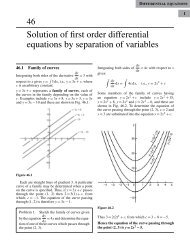differentiation
Create successful ePaper yourself
Turn your PDF publications into a flip-book with our unique Google optimized e-Paper software.
304 DIFFERENTIAL CALCULUS<br />
Since the gradient changes from negative to<br />
positive, the point (1, 3) is a minimum point.<br />
Considering the point (−1, 7):<br />
If x is slightly less than −1, say −1.1, then<br />
dy<br />
dx = 3(−1.1)2 − 3,<br />
which is positive.<br />
If x is slightly more than −1, say −0.9, then<br />
dy<br />
dx = 3(−0.9)2 − 3,<br />
which is negative.<br />
Since the gradient changes from positive to<br />
negative, the point (−1, 7) is a maximum<br />
point.<br />
(b) Since dy<br />
dx = 3x2 − 3, then d2 y<br />
dx 2 = 6x<br />
When x = 1, d2 y<br />
is positive, hence (1, 3) is a<br />
dx2 minimum value.<br />
When x =−1, d2 y<br />
is negative, hence (−1, 7)<br />
dx2 is a maximum value.<br />
Thus the maximum value is 7 and the minimum<br />
value is 3.<br />
It can be seen that the second differential method<br />
of determining the nature of the turning points<br />
is, in this case, quicker than investigating the<br />
gradient.<br />
Problem 12. Locate the turning point on the<br />
following curve and determine whether it is a<br />
maximum or minimum point: y = 4θ + e −θ .<br />
Since y = 4θ + e −θ<br />
dy<br />
then<br />
dθ = 4 − e−θ = 0<br />
for a maximum or minimum value.<br />
Hence 4 = e −θ ,<br />
4 1 = eθ , giving θ = ln<br />
4 1 =−1.3863<br />
(see Chapter 4).<br />
When θ =−1.3863, y = 4( − 1.3863) + e −(−1.3863)<br />
= 5.5452 + 4.0000 =−1.5452.<br />
Thus (−1.3863, −1.5452) are the co-ordinates of the<br />
turning point.<br />
d 2 y<br />
dθ 2 = e−θ .<br />
When θ =−1.3863,<br />
d 2 y<br />
dθ 2 = e+1.3863 = 4.0,<br />
which is positive, hence (−1.3863, −1.5452) is a<br />
minimum point.<br />
Problem 13. Determine the co-ordinates of the<br />
maximum and minimum values of the graph<br />
y = x3<br />
3 − x2<br />
2 − 6x + 5 and distinguish between<br />
3<br />
them. Sketch the graph.<br />
Following the given procedure:<br />
(i) Since y = x3<br />
3 − x2<br />
2 − 6x + 5 3 then<br />
dy<br />
dx = x2 − x − 6<br />
(ii) At a turning point, dy = 0. Hence<br />
dx<br />
x 2 − x − 6 = 0, i.e. (x + 2)(x − 3) = 0,<br />
from which x =−2orx = 3.<br />
(iii) When x =−2,<br />
y = (−2)3<br />
3<br />
When x = 3,<br />
− (−2)2<br />
2<br />
− 6(−2) + 5 3 = 9<br />
y = (3)3<br />
3 − (3)2<br />
2 − 6(3) + 5 3 =−115 6<br />
Thus the co-ordinates ( of)<br />
the turning points<br />
are (−2, 9) and 3, −11<br />
6<br />
5 .<br />
(iv) Since dy<br />
dx = x2 − x − 6 then d2 y<br />
dx 2 = 2x−1.<br />
When x =−2,<br />
d 2 y<br />
= 2(−2) − 1 =−5,<br />
dx2 which is negative.<br />
Hence (−2, 9) is a maximum point.<br />
When x = 3,<br />
d 2 y<br />
= 2(3) − 1 = 5,<br />
dx2 which is positive.










